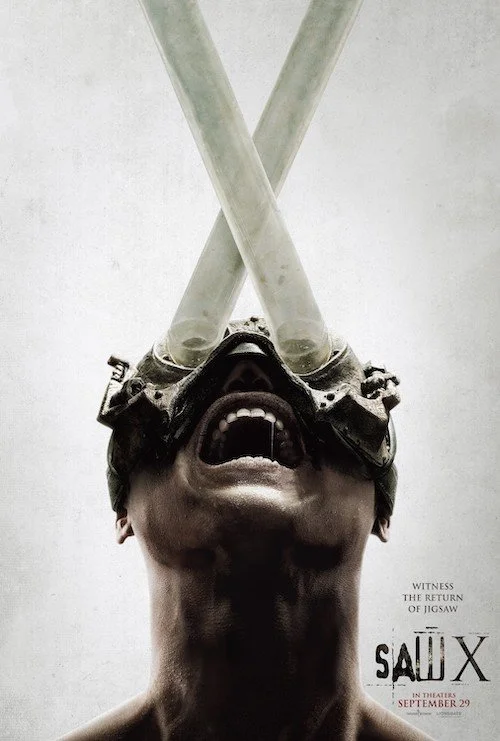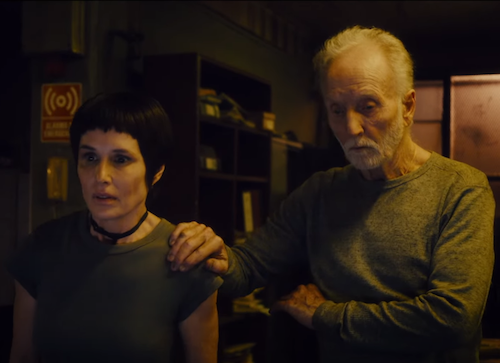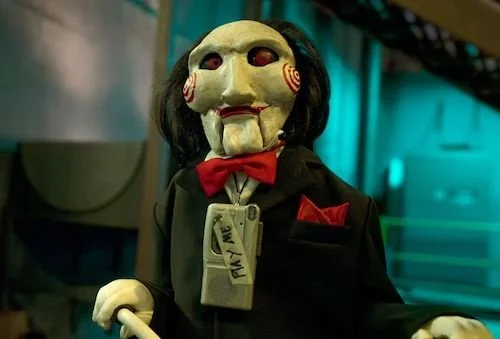Saw X
Written by Jon Wedge
Being the month of Halloween, October is the perfect month to focus on horror for those of us in the spooky spirit. Many of us who grew up on horror movies used this as an opportunity to marathon our favorite varieties, whether they be of old Hollywood or Japanese monster pictures, low-budget direct-to-video B-movies (that the only people you know who have also heard of it are on the internet), or the good old slasher flick franchises (and everything in between). While most of us grew up with Jason Vorhees, Michael Myers, Freddy Krueger, or Pinhead, the killer I couldn’t get enough of from the point I was introduced at age fourteen was John Kramer, the Jigsaw killer of the Saw franchise.
Whereas many other popular slashers have banal (if not non-existent) motivations for their body count, killing for the sake of evil compulsion and often without much if any personality, John Kramer was a complex person, a highly skilled and intelligent tactician, and had a sympathetic backstory and the charisma to sell it to his cult in-universe and in-audience. While other slashers would occasionally find new ways to stab their victims, Jigsaw had an undeniable style, continually using his engineering talents to present inventive and stylistically poetic traps for his victims to endure, often tailored to the sins Kramer perceives in his respective subjects with a nihilistic sense of humor. Jigsaw didn’t outright kill his victims, he tormented and humiliated them and gave them a chance to prove their Will to Power, or die; regardless, they will feel pain. At the center of the character is actor Tobin Bell, who masterfully conjures up a man who is equal parts calculating, menacing, compassionate, philosophical, and frail.
Tobin Bell has returned to play another game in franchise veteran Kevin Greutert’s Saw X, a “mid-quel” set between the events of the original film and the first sequel. On paper, this is the best decision the producers of the film could have made, because even for those of us who have stuck with the series and generally enjoyed most of the entries, the decision to kill off Kramer in the third film and reduce his role to flashback cameos did present some obstacles in the long-run, as it became clear that John Kramer (and by extension, Tobin Bell) was the thing even more so than the traps that kept us coming back for more. 2017’s Jigsaw experimented with the idea of reviving the franchise, combining a prequel story to incorporate the titular character in the flesh. After the previous entry, the spin-off Spiral, proved to be the series’ least lucrative release (the pandemic certainly didn’t help but it’s arguably the weakest entry anyway), going back to formula and bringing back Bell (and Kramer) back to Saw was a wise choice that is proving to revitalize the Saw brand. And oh yes, there will be blood.
The Game
Heed my warning: there are spoilers ahead, so you may want to scroll carefully. Read or don’t…make your choice
Saw X is a fitting entry in the beloved horror franchise even with its overly polished nature.
After Dr. Lawrence Gordon passes Jigsaw’s test in the bathroom game of the original film, John Kramer has not given up on his fight for his life in his battle with brain cancer. Told by a new doctor that he has months to live and unwilling to stop fighting, John keeps reviewing his options and attends cancer support groups when he comes in contact with a fellow support group attendee who tells him that his once-terminal cancer is in remission thanks to an alternative treatment based out of Norway. John researches the treatment and is able to set up an appointment for his own operation in Mexico. John arrives at the facility for his surgery and all goes well, waking up to results stating his cell counts are normal and the cancer is gone—John can now enjoy his life.
At this point in the film, it’s clear that, despite the return of John Kramer to the screen, this is a very different Saw movie. The editing and story flow is the most straightforward of any previous film, and the cinematography is a lot cleaner. Rather than being the antagonist, Kramer is the protagonist of Saw X. This perspective makes him appear more sympathetic, and Bell’s portrayal of an increasingly weakening man fuels that sympathy. Most strikingly, the traps have been absent thus far, with the only one game yet shown turning out to be John daydreaming when catching a member of hospital staff attempting to steal from a patient. Furthermore, this imagined game (heavily featured in the promotional material and theatrical poster) is rather tame for a Jigsaw trap. I don’t like to often say I could survive horror movie predicaments, but this might have been Jigsaw’s most winnable game (turn the knob with one hand to break the fingers of the other, or your eyes will get sucked out of the sockets. It’s gonna suck but the cost-benefit is obvious, crank that knob like the volume dial). Otherwise, the only other body horror we have experienced so far is the image of brain surgery on a monitor during John’s operation. We even see John working on designs for a trap we see appear in Saw III, only for him to crumple the sheet of paper and throw it away. Could John be thinking of giving up his games in the face of his new lease on life?
Unfortunately, there is no such lease. It doesn’t take longer after the surgery for John to learn that the entire procedure was actually a farce, part of a long-running con job by the people he met at the facility in Mexico. Angered that he has been given false hope and knowing that these people have similarly scammed millions of dollars out of dozens of people, John is ready to present to the audience the one thing besides himself that brought us here: a new game.
John first captures the man who drove him to the facility and secretly posed as his operating doctor. The victim plays his game alone and is forced to use the scalpels duct taped to his hands to cut off the flesh of his forearms and remove the pipe bombs sewn into his muscles. He succeeds, and John immediately appears to provide first aid. With help from a familiar face in Amanda Young, Jigsaw’s real game can begin, and one by one they test those involved in the con in one room. The first of these victims successfully cuts off her leg but is unable to drain enough bone marrow from her femur to be freed from her trap and is decapitated. The man who posed as his anesthesiologist was forced to cut into his skull and remove a piece of his brain—no anesthesia. He is able to do so but not in enough time and his head gets enclosed in a device that burns him to death. The next victim, whom is the most unfortunate of all of them as she’s clearly manipulated with her addiction by the others (this brings remorse from Amanda, a recovering addict herself and plants small fissures between her and John that we see come to a head in Saw III), survives being hanged in front of a radiation machine and burned by using a hammer to crush her foot and hand and slip free of her shackles.
Before the final game can begin with the woman who masterminded the con, a man who posed as a patient to sell the treatment to John (and has been trying to maintain that he was also scammed) reveals that he’s partnered with the leader and he manages to free her and shackle John to her trap, while also imprisoning Amanda on the other side of the room. The con leader kills the girl who survived the previous trap, which upsets John. She then kidnaps a local boy whom John befriended earlier who was playing outside and forces John to play his own trap against the child: they are going to be waterboarded by blood, and only one will survive.
John will not allow the young boy to die and prepares to sacrifice himself, pulling the lever on the platform while instructing the boy not to pull his lever, which keeps the boy safe and all of the blood pouring into John’s face while Amanda helplessly watches. When the grifters leave to take back the money they stole from John, the boy courageously pulls his lever, causing the platform to shift and forcing the blood to pour into his own face to give John a reprieve. John overpowers the boy and pulls his lever again, but before he can drown in blood, the famous theme music begins as the villains grab the bag of money, locking them into a room with acidic gas and allowing for only one survivor (the leader, who is stuck in the room with only her head sticking out of a hole in the wall). This also triggers a killswitch that saves John and the boy.
While there’s some nice dramatic gravitas leading up to the climax, I do feel that John sacrificing his safety for the boy to be rather heavy-handed. When the leader of the con pleads to John that what he is doing isn’t right, John will not hear moral lecturing from a person who scams dying people out of their money and their hope. She turns John’s words around on him when he protests involving a child in his game, it falls a little flat to those who actually know this series because anyone who has seen multiple Saw films could tell you that we know that John Kramer would never harm an innocent little kid; we don’t need the script to clarify that it goes against Kramer’s ethics. At the end of the day, John Kramer is still a monster, and while we do enjoy seeing his compassionate side because it helps make him compelling, the series is at its best when it leans into his cruelty with bits of compassion.
In a scene that appears (sigh) mid-credits, we see another familiar face: Detective Mark Hoffman, who has aided John in trapping the man who first led John to the scammers and had been faking his own illness and treatment. This victim is hung up with a device of blades that threatens his stomach, inside of the dilapidated bathroom where it all began in Saw, cutting to black before we get to see the game unfold. Kramer has been brushed with death again and his will to survive has been rejuvenated, and his work will continue. I don’t mind the setup for future instalments, especially if it leads to another story with Dr. Gordon, but the presentation of Hoffman’s cameo in the form of a post-ending sequence gives in a fan service nature that is not only unnecessary (Saw has always been able to leave setups without the use of these), but frankly unwelcome in the age of MCU-fatigue.
End of spoilers. Most people are so ungrateful to be warned of spoilers, but not you. Not anymore
The Judgement
Saw X is a “thank you” to long-time fans of the series, even when it gets in its own way.
Before my viewing of Saw X, I thought it was curious that it was receiving unusually good reviews, as even the first Saw was polarizing to critics and the sequels have been largely lambasted. I wondered if Saw was going to perhaps receive a re-appraisal (I’ll make a case for this shortly).
After viewing, I now know why critics are going easy on it: because the grim and rough edges have been smoothed down, making a film that is more palatable to general audiences, with John Kramer getting more sympathetic treatment and the grotesque aesthetics and nihilistic tone heavily toned down, in large part due to the more standard photography (gone are the bleary greens and browns and blues that filtered our experience for most of the series).
And the end result is a decent film that is perhaps the most technically well-made and focused of the series, but it does come at a cost of some of the aesthetic traits for which Saw has always been known. This isn’t inherently a bad thing and it may have breathed new life into the franchise going forward, but if toning down the grim nature of the series continues to trend, it may violate the spirit of the entire thing and alienate the fanbase.
Horror films have an interesting dynamic with their audiences compared to that of other cinema-goers, in that they tend to abide by their own unspoken set of rules that fly in the face of mainstream film criticism; their often violent and macabre nature makes them unappealing to a large portion of movie-goers, giving horror films their own subculture and resulting in a genre of films that are often created by fans, for fans.
As someone who loves a good horror movie, there are consequences to horror’s insulated nature with its audience, and that is a lot of very bad films are made, especially if the producers can attach a known name to the title. As mentioned earlier, while I have mixed feelings about other slasher franchises, Saw has always stood out above the rest for me because it subverts a number of the shortcomings of this class of films. The films have an overarching plot that is fun to watch unfold through all of their convoluted twists and turns. The killer is an interesting person rather than a faceless ghoul, and his complex characterization makes him perhaps the most captivating character in all of cinematic horror aside from maybe Hannibal Lecter. Furthermore, the methodology of having his body count perpetrated by the victims themselves is an ingenious way of turning convention on its head.
I’m not trying to sell you on Saw if you’ve already experienced it and tapped out. These films aren’t for everyone and I’m fully aware of (and embrace) their convoluted plot lines, the edgy nihilism, the vaguely Nietzschean philosophy, and the cruel, violent decadence of the gore and body horror and psychological torment. Much like the traps themselves, watching a Saw film is like an endurance challenge of its own, and if you’re in the mood for biting your shirt and playing a game, Saw X is a fun game to play, and it may be an easier game than the previous sequels.
Jon Wedge is a contributing writer from Grand Rapids, Michigan, with a love for cinema that emotionally scars its audience, and a particular interest in 21st century cinema.







